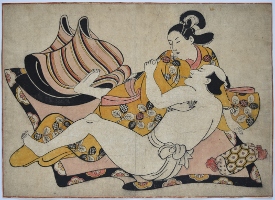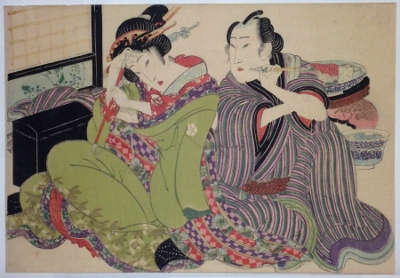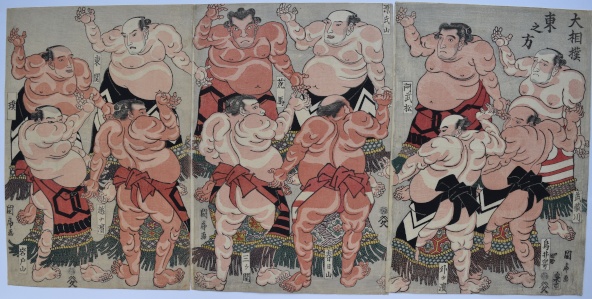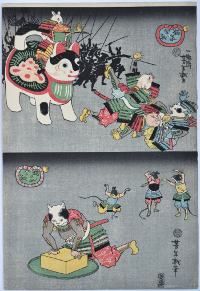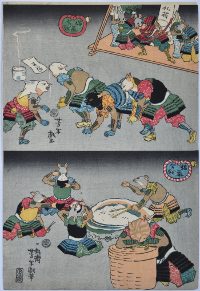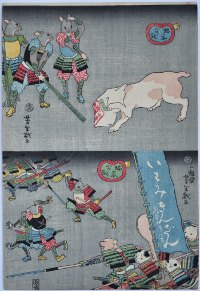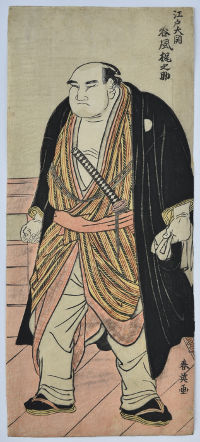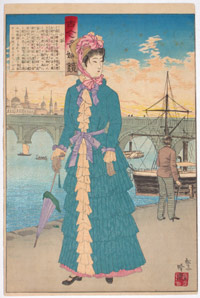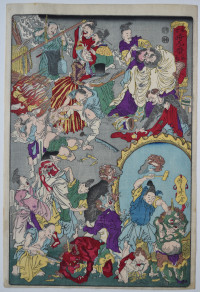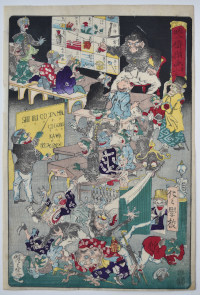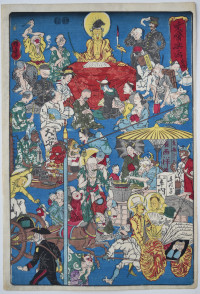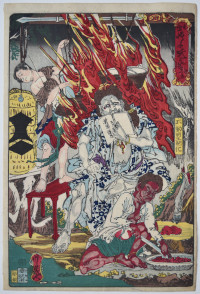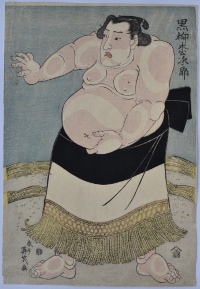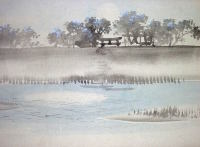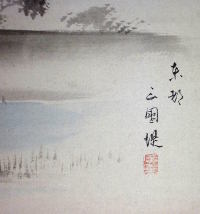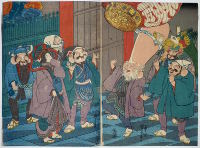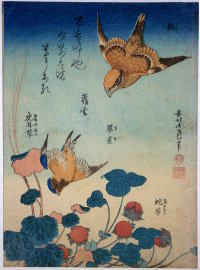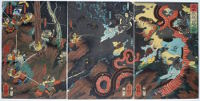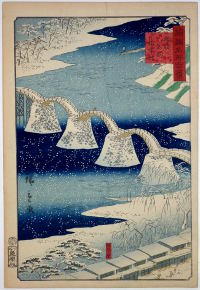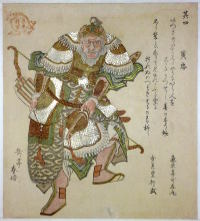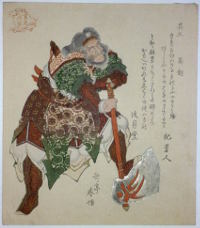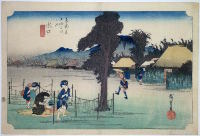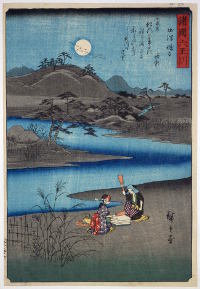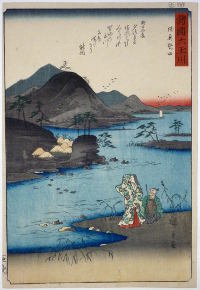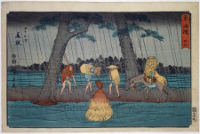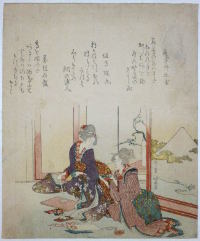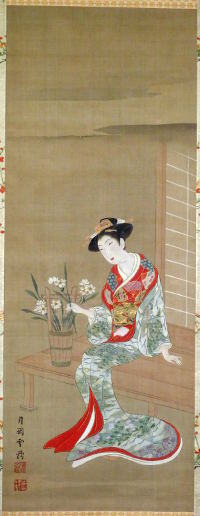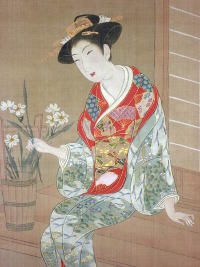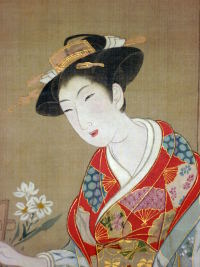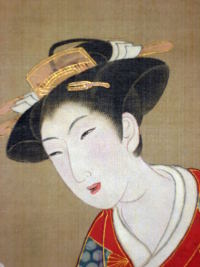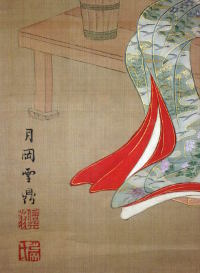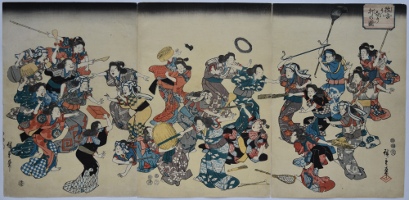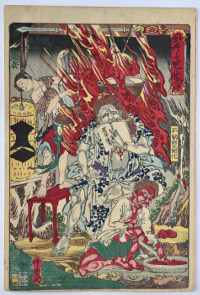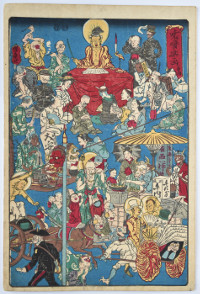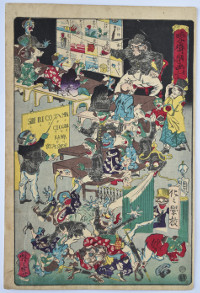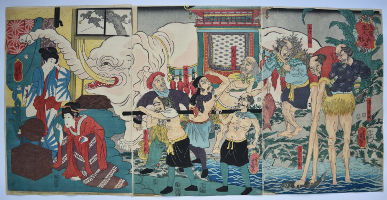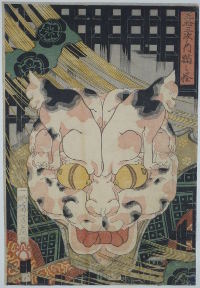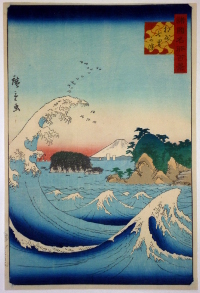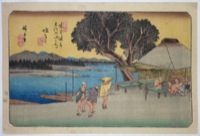/category/archive/page/24/
Hishikawa MORONOBU (c. 1618-1694)

Click here to view image full size.
The father of Ukiyo-e and the first to design single-sheet prints. Illustrated numerous books and produced a considerable number of paintings. A good proportion of his output was in the form of shunga. The print here is, arguably, from his finest shunga album. A set of 12 prints, although it is known in two versions with two alternative designs making a total of 14 sheets. For one complete set see Shunga The Art Of Love In Japan, Tom and Mary Evans, Paddington Press, 1975, Illus. 5.10-5,21. Rare.
Very good impression. Original hand-colouring. Minor marks and signs of mounting au verso, but otherwise very good condition.
Status: Sold
Katsushika HOKUSAI (1760-1849)
Click here to view image full size.
One sheet from a shunga set of 12 prints Ehon tsuhi no hinagata, “Patterns of Loving Couples.” Published 1814. The series title is a play on words. Tsuhi can be read as “couple” or “male and female pairs” or it can be pronounced tsubi, an old term for vulva.
Very good impression and colour. Slight soil and the usual slight centre fold, otherwise very good condition.
Status: Sold
Okumura MASANOBU (1686-1764)

Click here to view image full size.
Shogatsu, “First Month” from a shunga set Someiro no yama neya no hinagata, “Mountains of Dyed Colours, Examples for the Bedroom.” Shows a New Year scene with the master of an opulent household enjoying the holiday with his wife and a young man of his fancy. The poem alludes to the pleasures of both male-male and male-female sex. Published c 1740. Others from the set are illustrated in Tim Clark, Shunga:Sex and Pleasure in Japanese Art, BM, 2013, pp. 147-151. Masanobu is one of the most important figures in Ukiyo-e being the proprietor of a shop but also a publisher, an illustrator of books, print publisher, painter, and inventor of the hashira-e and uki-e as well as being at the forefront of advancements in colour printing. Rare.
Fine impression. Hand colouring, slightly faded. Minor backed wormage, but otherwise very good condition given the date.
Status: Sold
Attributed to Torii KIYONOBU II (Active 1710s – 1760)
Click here to view image full size.
A sumizuri-e abuna-e sheet from a shunga set published c. late 1710s. MFA has 10 sheets from the set , RES.09.310.1 to .10. They are based on designs by his father, Torii Kiyonobu I.
Fine impression. Fine hand-colouring. Backed (from a scroll), some light soil and minor creasing, all appropriate with date.
Status: Sold
Katsushika HOKUSAI (1760-1849)
Click here to view image full size.
One sheet from a shunga set of 12 prints Ehon tsuhi no hinagata, “Patterns of Loving Couples.” Published 1814. The series title is a play on words. Tsuhi can be read as “couple” or “male and female pairs” or it can be pronounced tsubi, an old term for vulva.
Very good impression and colour. Slight soil and the usual slight centre fold, otherwise very good condition.
Status: Sold
Keisai EISEN (1790-1848)
Click here to view image full size.
A pair of lovers from the set Keisei higo “The Secret Language of Courtesans.” This fine set of abuna-e (shunga prints that omit any explicit sex – quite literally “risky pictures”) was privately published c 1822-5. The pre-coital coupling is indicated by the wad of tissue slipped into her obi.
Fine impression and colour. Very good condition. This set employs brass into the printing which is often the cause of the paper degrading and falling out. (Not evident here.) Unsigned as always.
Status: Sold
Utagawa YOSHIHARU (1828-1888)
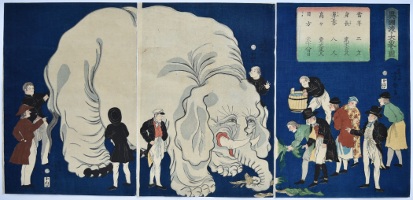
Click here to view image full size.
A triptych showing a large elephant being inspected, watered and fed by foreigners. Ikoku watari taizo no zu. “Picture of a Big Elephant Brought from Overseas.” Beside the title in a box are the details of the animal: Three years old this year (1868); length 6 metres 38 cms; length of nose 3 metres 4 cms; tall 3 metres 76 cms; weight 2800 me. Published by Yamaguchiya Tobei. Rare: Not in any of the standard Yokohama books.
Fine impression and colour. Very good condition. Signed Ichibaisai Yoshiharu ga.
Status: Sold
Ichiryusai HIROSHIGE ( 1797-1858 )
Click here to view image full size.
An original painting of the Sumida riverbank at Mimeguri, Toto ( Edo ). A full moon rises above a tori and is reflected in the river. Possibly originally from a makemono. Sumi and light colour on paper, 7.9 x 21.9 in; 20 x 55.5 cms. Sealed with a Ryusai seal used in his later years.
Status: Sold
Katsushika HOKUSAI ( 1760-1849 )
Click here to view image full size.
Shrike and wild strawberry from the so-called Small Flower series of ten chuban prints published c 1832. Amongst the most sought- after of Hokusai’s prints. The first edition ( as here ) was published by and has the seal Eijudo. A later edition has combined manji and kiwame seal ( and some are printed on thin Chinese-style paper ), and there are also impressions extant without any seals which probably constitute a third state. All impressions are rare and the first state excessively so. Indeed, these prints are considered even rarer than the larger bird and flower set Hokusai designed c 1833. The printing and colour on this set comes close to surimono quality. Each print has a Chinese poem written in hiragana.
Fine impression and colour. Minor soil, otherwise very good condition. Signed Zen Hokusai Iitsu hitsu.
Status: Sold
Totoya HOKKEI ( 1780-1850 )
Click here to view image full size.
A mounted sage followed by his servant crossing a bridge over a lake. One of an excessively rare chuban series with title Toshi gafu no uchi, “Drawing Album for Chinese Poems” printed in red, and sub-title Toshin denshi. Printed in tones of blue except for a light flush on the horizon. Another impression ( trimmed ) was in the Vever collection ( ex Hayashi ), Sotheby’s, Part III, lot 295. Other impressions ( damaged ) are in the BM, ref: 1937, 0710,0,229 and Honolulu Museum of Art, ref: 14466. Hokkei was one of Hokusai’s best pupils and designed many fine surimono. Unidentified publisher’s seal and censor’s seal in right margin ( trimmed off on the other impressions ).
Fine impression and colour. Very good condition. Signed Hokkei.
Status: Sold
Ichieisai YOSHITSUYA ( 1822-1866 )
Click here to view image full size.
A triptych with title Taiheiki Yakiyama-Goye no zue, “Picture of the Slope of Burning Mountain in the Taiheiki.” Sato Masakiyo ( = Kato Kiyomasa ), far left, and his men encountering a monstrous serpent surrounded by bats and flying goblins on a haunted mountain . Published by Kagaya Kichibei, 5/1861.
Fine impression, colour and condition. Signed Ichieisai Yoshitsuya ga.
Status: Sold
Utagawa HIROSHIGE II ( 1826-1869 )
Click here to view image full size.
Hiroshige II’s best print. Suo Iwakuni no Kintaibashi, “The Kintai Bridge, Iwakuni in Suo Province.” From Shokoku meisho hyakkei, “One Hundred Views of Famous Places in Various Provinces.” Published by Uoya Heikichi 11/1859.
The rare first edition has a variegated sub-cartouche but this is still an extremely early impression with the green on the banks top right ( missing on later editions ); light blue on the water, and gradation and mica on the roofs at bottom. Fine colour. Small repaired binding holes in left margin, otherwise fine condition. Signed Hiroshige ga.
Status: Sold
Yashima GAKUTEI ( 1786-1864 )
Click here to view image full size.
A surimono showing the Chinese warrior Huang Zhong ( Jap: Ko Chu, d. 220 AD ). Best known for his role in the novel Tale of the Three Kingdoms. He is shown wearing tiger skin breeches and armed with a large sword, bow and arrows. From a set Go koshogun, “The Five Tiger Generals.” Title on right Sono yon Ko Chu, “Nr 4 Huang Zhong. “ Issued by the Asakusagawa Poetry Club ( seal top left ) for the Tiger year 1818. Two poems by Shinsokutei Kashimaru ( right ) and Hogetsudo Yukitake ( left ).
Fine impression. Very good colour with extensive gold and silver. Very good condition. Signed Gakutei Harunobu.
Status: Sold
Yashima GAKUTEI ( 1786-1864 )
Click here to view image full size.
A surimono showing the Chinese warrior Ma Chao ( Jap: Ba Cho, 176-222 AD ). Best known for his role in the novel Tale of the Three Kingdoms. He is shown leaning on a giant axe. From a set Go koshogun, “The Five Tiger Generals.” Title on right Sono go Ba Cho, “Nr 5 Ma Chao. “ Issued by the Asakusagawa Poetry Club ( seal top left ) for the Tiger year 1818. Two poems by Ki no Yoshito ( right ) and Sengetsudo ( left ).
Fine impression. Very good colour with extensive gold and silver. Very good condition. Signed Gakutei Harunobu.
Status: Sold
Ichiryusai HIROSHIGE ( 1797-1858 )
Click here to view image full size.
Minakuchi, Station 51 from the Tokaido gojusantsugi, “Fifty-three Stations of the Tokaido Road.” The set published by Hoeido and Senkakudo, c 1833-4. Shows the village women, at left, peeling and drying gourds to make the famous kampyo.
Exceptionally early printing. Probably first edition. Fine colour. Very slight centre fold, otherwise fine condition. Signed Hiroshige ga.
Status: Sold
Ichiryusai HIROSHIGE ( 1797-1858 )
Click here to view image full size.
Toi Tama River in Settsu Province with a poem by Minamoto no Toshiyori from the series of six prints Shokoku Mutamagawa , “Six Jewel Rivers in the Provinces.” Shows women fulling cloth beneath a full moon. The set published by Maruya Kyushiro 11/1857.
Superb impression. Fine colour and condition. Signed Hiroshige ga.
Status: Sold
Ichiryusai HIROSHIGE ( 1797-1858 )
Click here to view image full size.
Noda Tama River in Mutsu Province with a poem by Noin from the series of six prints Shokoku Mutamagawa , “Six Jewel Rivers in the Provinces.” Shows a Heian beaty and attendant admiring the view. The set published by Maruya Kyushiro 11/1857.
Very fine impression, colour and condition. Signed Hiroshige ga.
Status: Sold
Ichiryusai HIROSHIGE ( 1797-1858 )
Click here to view image full size.
Fujieda, no. 23, from the so-called Reisho Tokaido because of the formal script used for the title. One of the best designs from the set. Travellers well covered against the rain traversing a path between fields.
Fine impression and colour. Very good condition. Signed Hiroshige ga.
Status: Sold
Katsushika HOKUSAI ( 1760-1849 )
Click here to view image full size.
A surimono showing two young girls making new year envelopes. On the side screen is a view of Fuji. Three poems above. Published c 1806.
Fine impression and colour. Small strengthened area au verso, otherwise very good condition. Signed Hokusai ga.
Status: Sold
Tsukioka SETTEI ( 1710-1786 )
Click here to view image full size.
An original painting showing a beauty sitting on an engawa having picked flowers which she is placing in a wooden bucket beside her. Settei produced many illustrated books but after around 1765 turned towards painting beauties, courtesans and geishas. They are of the utmost refinement – the faces and limbs picked out in red, their costumes often having areas of gold, and invariably have the wide lantern-locks ( toro-bin ) hairstyle. Settei also excelled at shunga painting. Sumi and full colour with details picked out in gold on silk. 30.75 x 11.5 in; 78.1 x 29.2 cms. Minor creasing but otherwise very good condition. An elaborately embroidered mount. Painted c 1770. Signed Tsukioka Settei with seals Shinten’o and Tsukioka shi.
Status: Sold
Utagawa YOSHIFUJI ( 1828-1887 )
Click here to view image full size.
The head of the cat-witch of Okabe from the Fifty-three Stations. The head is composed of convoluted cats’ bodies; the eyes being two bells that are usually found round cats’ necks and the mouth a thick ribbon as worn by cats. Any young girl visiting the temple was at risk of being greeted by an old woman who would offer her accommodation for the night, only to transmogrify into a cat-witch and devour them. The print was published c 1847 by ( appropriately ) Kita. Extremely rare and a great 19th century design.
Fine impression and colour. Small corner repair bottom right and slight strengthening au verso of weak lines. But generally good condition. Full size. Signed Ipposai Yoshifuji ga.
Status: Sold
Ichiryusai HIROSHIGE II ( 1829-1869 )
Click here to view image full size.
The foremost pupil of Hiroshige. Formerly called Shigenobu, he assumed the name Hiroshige II on Hiroshige’s death and married his daughter. Shows Soshu Shichirigahama, the “Seven Ri Beach” near Kamakura, Kanagawa Prefecture. From the set Shokoku meisho hyakkei, “The One Hundred Views of Famous Places in the Provinces.” From the beach one gets a clear view of Fuji and Enoshima Island – both framed by a giant wave. The set ( of which only 80 are known ) was published by Uoya Eikichi 1859-61 ( this being 1859 ).
Very good impression and colour. Margins trimmed close, otherwise very good condition. Signed Hiroshige ga.
Status: Sold
Ichiryusai HIROSHIGE ( 1797-1858 )
Click here to view image full size.
Shionata from Kisokaido rokujukyutsugi no uchi, “Sixty-Nine Stations of the Kisokaido.” The set of seventy prints was started by Eisen and published by Hoeido in 1835, but in 1837 Hiroshige took over and completed the series with the publisher Iseya Rihei ( Kinjudo ). Shows the eastern shore of the broad Chikuma River. Three boatmen walk towards porters resting in a hut. Travellers could hire a boat or engage porters to bear them across the river on platforms held above the water. There are numerous triptychs showing this by Hiroshige and other artists.
Very good impression, colour and condition. Signed Ichiryusai Hiroshige ga.
Status: Sold

